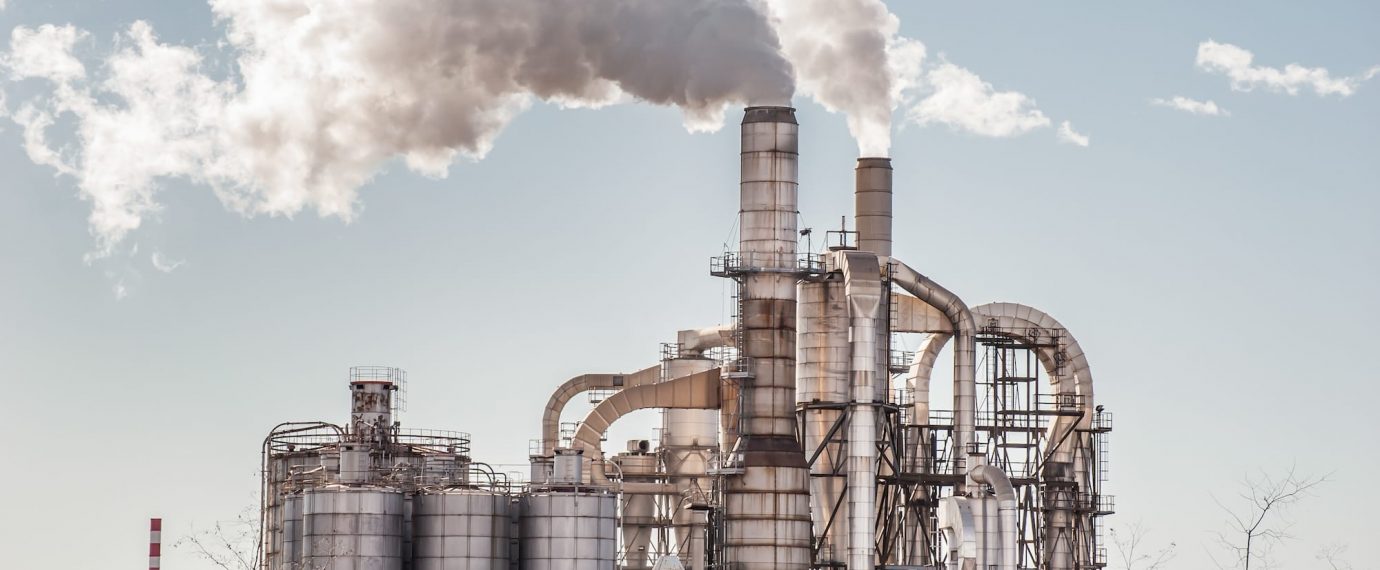By Cynthia Olley, Sr. Manager – Environmental, U.S. Compliance
Air permitting plays a vital role in environmental compliance for industrial and manufacturing operations. Whether your facility operates a single coating booth or runs a complex production line with multiple emission points, understanding air permitting requirements is critical for maintaining compliance, protecting public health, and avoiding costly regulatory missteps.
This guide covers the foundational elements of air permitting in the United States, from the Clean Air Act and permit types to emissions calculations, reporting responsibilities, and common compliance pitfalls.
The Clean Air Act
The foundation of air permitting in the United States lies in the Clean Air Act (CAA), first passed in 1963 and significantly amended in 1970, 1977, and 1990. The law is administered by the U.S. Environmental Protection Agency (EPA) and forms the regulatory backbone for air quality management across the country.
Two key provisions of the CAA shape permitting requirements:
- National Ambient Air Quality Standards (NAAQS): These define acceptable concentration levels for six common pollutants—also known as criteria pollutants—to protect public health and the environment.
- State Implementation Plans (SIPs): These require states to adopt and enforce air quality regulations consistent with NAAQS and other federal requirements.
In addition, the Act establishes key permitting programs:
- New Source Performance Standards (NSPS)
- National Emission Standards for Hazardous Air Pollutants (NESHAPs)
- Title V Operating Permits for major sources
Permitting Basics: Purpose, Types, and Applicability
An air permit is a legally enforceable authorization for a facility to emit certain pollutants under specific conditions. Its purpose is to ensure that industrial emissions comply with all applicable regulations at the federal, state, and local levels.
Permits typically include:
- Emission limits
- Operating conditions
- Monitoring and reporting requirements
Types of Air Permits
Depending on the type and quantity of emissions, a facility may need one or more of the following permits:
- Construction Permits (Preconstruction or New Source Review)
Required before installing or modifying equipment that could increase emissions. - Operating Permits (State, PSD, FESOP, or Title V)
These outline ongoing compliance obligations. Title V permits are mandatory for major sources. - General Permits
Streamlined options for common activities (e.g., paint booths or small degreasers).
Permitting is generally handled at the state level through agencies authorized by the EPA, though local districts may impose stricter rules.
Understanding the Criteria Air Pollutants
Under the Clean Air Act, the EPA regulates six criteria air pollutants based on their known health and environmental impacts:
- Particulate Matter (PM10 and PM2.5): Fine particles that can penetrate the lungs and cause respiratory problems.
- Ground-level Ozone (O₃): A key smog component formed from reactions between VOCs and NOₓ in sunlight.
- Carbon Monoxide (CO): A toxic gas produced by incomplete combustion, especially dangerous in enclosed areas.
- Sulfur Dioxide (SO₂): Emitted from burning coal or oil; contributes to acid rain and respiratory issues.
- Nitrogen Dioxide (NO₂): Formed during combustion; contributes to smog and ozone formation.
- Lead (Pb): A neurotoxic metal formerly associated with gasoline and industrial processes.
Each pollutant has corresponding standards under NAAQS, which drive permitting thresholds and control requirements.
Common Emission Sources
Facilities must identify all sources of emissions to determine permitting needs and ensure accurate reporting. Typical sources include:
- Combustion Equipment: Boilers, furnaces, engines, turbines
- Process Equipment: Paint booths, coating lines, chemical processes
- Material Handling and Storage: Conveyors, silos, tanks
- Control Devices: Scrubbers, oxidizers, baghouses (which can emit if faulty)
- Fugitive Emissions: Leaks from pumps, valves, or transfer areas
- Cleaning Activities: Use of solvents and degreasers
Each source must be evaluated for its emission potential and regulatory applicability.
Calculating Emissions
Accurate emission calculations form the backbone of any air permitting program. Whether you’re determining if a permit is required or estimating compliance margins for an existing permit, the integrity of your emissions data is critical.
Step 1: Identify All Emission Sources
Start with a comprehensive inventory of all emission-generating equipment and activities at your facility. This includes:
- Point sources (e.g., stacks, vents)
- Fugitive sources (e.g., leaks from valves or equipment)
- Intermittent sources (e.g., emergency generators, maintenance activities)
- Insignificant or exempt activities (note these for documentation purposes)
Ensure nothing is excluded—even small or infrequently used equipment can impact totals when aggregated.
Step 2: Gather Operational and Chemical Use Data
Accurate input data is essential. Depending on the process, this may include:
- Fuel consumption records (gallons, scf, BTUs)
- Raw material throughput (tons, gallons, lbs)
- Equipment specifications (design capacity, max load)
- Safety Data Sheets (SDSs) for coatings, solvents, or process chemicals
- Hours of operation
This information should reflect actual usage for “actual emissions” calculations and theoretical maximums for “potential to emit.”
Step 3: Apply Emission Factors or Test Data
Select the most reliable emission factors available. Common sources include:
- EPA’s AP-42 Compilation of Emission Factors
- Manufacturer-supplied data or guarantees
- Material balance methods (especially for VOCs and HAPs)
- Stack test results, when available and recent
For best accuracy, stack testing is preferred. However, if not feasible, conservative emission factors or engineering estimates may be used, as long as they are documented and justified.
Step 4: Calculate Actual and Potential Emissions
To calculate, use this formula:
Emissions (tons/year) = Activity Rate × Emission Factor × Time / Conversion Factor
For example, a natural gas-fired boiler might use the following:
- Natural gas use: 500,000 scf/year
- Emission factor for NOx: 100 lb/MMscf
- NOx emissions = (500,000 scf ÷ 1,000,000) × 100 lb = 50 lb = 0.025 tons/year
Repeat this for each pollutant and each source.
Potential to emit (PTE) assumes the source runs at full capacity, 24 hours a day, 365 days a year, unless enforceable limits are in place.
Step 5: Document Assumptions and Methods
Each calculation should be clearly documented, including:
- The source of emission factors
- Activity data and timeframes
- Any engineering assumptions
- Applicable control device efficiencies
- Supporting documentation (e.g., SDSs, logs, fuel invoices)
Incomplete or poorly documented emission estimates are a common cause of permit application delays and enforcement actions.
Step 6: Determine Applicability Thresholds
Once emissions are calculated, compare them to:
- Permitting thresholds for your state or local agency
- Major source thresholds (e.g., 100 tons/year for criteria pollutants, 10/25 tons/year for HAPs under Title V)
- De minimis or exempt levels where available
This will determine whether your facility qualifies as a minor source, a synthetic minor source (with limits to avoid major source classification), or a major source subject to Title V.
Step 7: Evaluate Control Options and Permit Strategy
If emissions are close to a threshold, consider operational or engineering controls to reduce PTE and simplify your permitting path. Options include:
- Throughput restrictions
- Operational limits (e.g., hours of operation)
- Pollution control devices (e.g., thermal oxidizers, baghouses, scrubbers)
These must be federally enforceable (i.e., written into a permit) to reduce your regulatory burden.
Air Emission Reporting Requirements
Many facilities are required to report air emissions annually or semiannually. These reports ensure transparency and help regulators monitor air quality trends.
Common reporting programs include:
- Annual Emissions Inventory
Required by most states for facilities over specified thresholds. - Greenhouse Gas Reporting Program (GHGRP)
Applies to large GHG emitters based on EPA criteria. - Toxics Release Inventory (TRI/Form R)
Required for certain facilities using specific toxic chemicals.
Late or inaccurate submissions can lead to penalties and increased agency oversight. Facilities should implement systems for data validation and timely reporting.
Compliance and Deviation Reporting
Once a permit is issued, it creates binding compliance obligations. Facilities must actively demonstrate adherence through:
- Monitoring and Recordkeeping
Track fuel usage, pressure drops, and key operating parameters. - Performance Testing
Conduct periodic stack testing or other efficiency evaluations. - Compliance Certifications
Submit annually or semiannually, signed by a responsible official. - Deviation Reports
Required if permit conditions are not met. Must include cause, duration, corrective actions, and prevention plans.
Timely and accurate reporting is essential to maintaining good standing with regulators.
Common Pitfalls in Air Compliance
Despite good intentions, facilities frequently encounter compliance challenges. The most common pitfalls include:
- Underestimating Emissions
Facilities often underestimate actual and potential emissions by relying on outdated emission factors, using limited operational data, or overlooking all emission sources. This can lead to the wrong permit classification or, more critically, operating without a required permit. To avoid compliance issues, emissions must be calculated conservatively and supported by credible, well-documented data. - Excluding Emission Sources
Not all small or infrequent emission sources are automatically exempt from permitting. Many facilities mistakenly assume an exemption applies without confirming the criteria or maintaining the necessary documentation. Exemptions often have specific size, throughput, or operational limits. Failing to evaluate or record these properly can leave a facility exposed during an agency inspection. - Omitting Deviation Reports
Air permits typically require facilities to report any deviations from permitted conditions, even if emissions remain within limits. Common oversights include failing to report a control device malfunction, missed recordkeeping, or operation outside permitted hours. Not submitting timely and complete deviation reports can result in Notices of Violation, even for minor issues. - Inconsistencies with TRI/Form R Submissions
Toxic Release Inventory (TRI) reporting and Form R submissions should align with the facility’s air permit data, including material usage and emissions estimates. Discrepancies between TRI reports and air permit records can raise red flags during audits or inspections. These inconsistencies often stem from using different assumptions, outdated data, or disconnected internal reporting processes. - Not Updating Permits After Operational Changes
When facilities modify operations, whether by increasing production, changing raw materials, or installing new equipment, those changes may impact emissions and permit applicability. Failing to assess and report these changes can result in operating under outdated permit terms, a violation that may trigger enforcement if discovered by regulators. - Poor Recordkeeping
Even when a facility operates within permitted limits, inadequate or disorganized recordkeeping can still lead to violations. Missing logs, incomplete throughput records, or improperly stored documentation make it difficult to demonstrate compliance. Permits often specify how long records must be retained and what data must be tracked; failure to meet these standards can undermine the facility’s compliance status. - Misunderstanding Regulatory Jurisdiction
While federal Clean Air Act requirements form the foundation of air permitting, many state and local agencies enforce additional rules. These may include lower emission thresholds, different control requirements, or more frequent reporting. Focusing solely on federal standards can lead facilities to overlook state-specific nuances and inadvertently fall out of compliance.
A proactive and organized compliance approach can reduce risk and streamline audits or inspections.
How to Stay on Track
- Review your current air permits or applicable regulations
- Confirm what’s required and determine applicability
- Collect accurate operational and emissions data
- Ensure consistency across reports and submissions
- Ask questions when in doubt or consult a professional
- Allow sufficient time for permit applications or updates
- Double-check reports before submission to ensure accuracy
Conclusion
Air permitting is an essential element of operating a responsible, legally compliant manufacturing facility. From understanding emissions sources to maintaining accurate records and submitting timely reports, environmental compliance requires diligence and attention to detail.
Given the evolving nature of regulatory requirements, many facilities benefit from outside support. If your company is preparing for operational changes, evaluating current compliance status, or planning for an upcoming inspection, now is the time to review your air permitting program.
Contact U.S. Compliance to assess your facility’s needs and ensure your air program aligns with today’s requirements.



